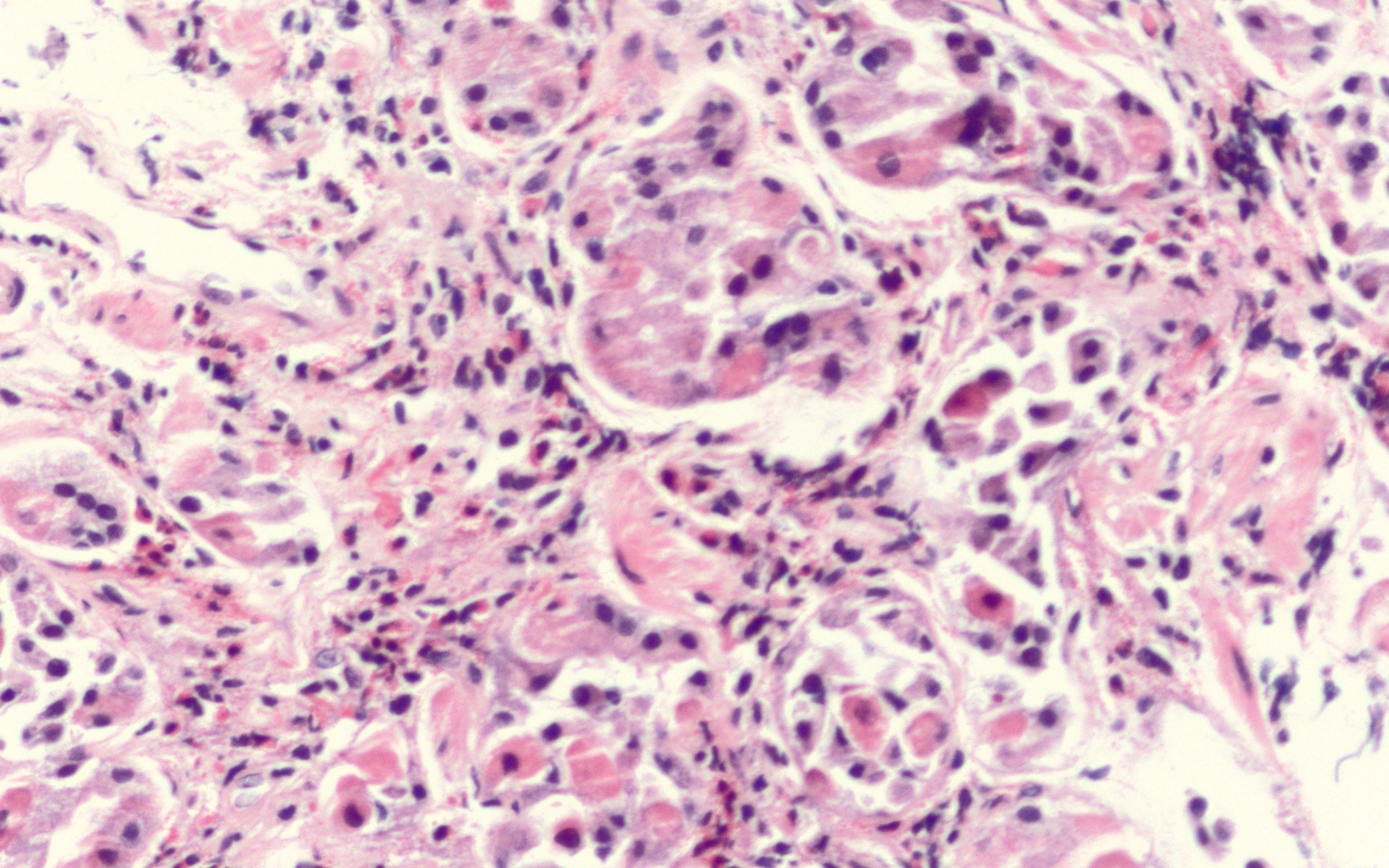Back
Poster Session E - Tuesday Afternoon
E0727 - Eosinophilic Gastritis in Idiopathic Hypereosinophilic Syndrome: A Case Report
Tuesday, October 25, 2022
3:00 PM – 5:00 PM ET
Location: Crown Ballroom

Ifrah Fatima, MD
University of Missouri-Kansas City
Kansas City, MO
Presenting Author(s)
Ifrah Fatima, MD1, Fouad S. Jaber, MD1, Adel Muhanna, MD2, Hanae Benchbani, MD2, Quinton Palmer, MD2, Husam Barakat, MD3
1University of Missouri-Kansas City, Kansas City, MO; 2University of Missouri, Kansas City, MO; 3University Health/Truman Medical Center, Kansas City, MO
Introduction: Idiopathic hypereosinophilic syndrome (IHES) is a group of myeloproliferative disorders causing multi-organ dysfunction with unknown etiology. We report a case of IHES in a patient presenting with gastric wall thickening, multiple organ damage including acute coronary syndrome, encephalopathy, and multiple cortical infarcts.
Case Description/Methods: A 47-year-old male patient with past medical history significant for type 2 diabetes mellitus and hypertension presented with nausea, vomiting, abdominal pain, and food intolerance for 7 days. He also complained of intermittent, substernal chest pain for 1-2 days at presentation. His labs were significant for elevated troponin of serum creatinine of 2.85mg/dL and significant leukocytosis (32.80 10^3/cmm). Absolute eosinophilic count was elevated at 14.70 10^3/cmm. Echocardiogram showed hypokinetic mid inferior and inferolateral walls. CT chest/abdomen angiogram was done for concerns of dissection. It showed diffuse gastric wall thickening with upper abdominal retroperitoneal lymphadenopathy and extensive retroperitoneal fat stranding. He was started on antiplatelet agent and heparin drip. Ischemic workup was deferred as troponin plateaued and patient had new-onset altered mental status. MRI brain showed numerous punctate cortical and subcortical foci of restricted diffusion consistent with acute watershed distribution infarcts.
In view of possible need for dual anti-platelet therapy and the high concern for gastric malignancy on CT that required tissue biopsy, gastroenterology was consulted for esophagogastroduodenoscopy (EGD). It did not show any gastric mass but diffuse gastritis. Biopsy showed mild chronic gastritis and a focal area showing increased eosinophilic infiltration with eosinophilic cryptitis (Figure 1). An extensive workup for eosinophilia including infectious etiology returned negative. No secondary causes of hypereosinophilia were identified.
Patient was started on 1mg/kg of prednisone with normalization of eosinophils to 0 within 24 hours. Steroids were tapered and patient improved clinically with resolution of altered mental status, abdominal pain, and chest pain. Follow-up EGD has been scheduled to re-evaluate eosinophilic deposits.
Discussion: The stomach biopsy showing eosinophilia was the key to diagnosis. Resolution of peripheral eosinophilia with steroids confirms the diagnosis in the absence of a secondary cause. A repeat EGD with biopsy is scheduled to look for histopathological resolution.

Disclosures:
Ifrah Fatima, MD1, Fouad S. Jaber, MD1, Adel Muhanna, MD2, Hanae Benchbani, MD2, Quinton Palmer, MD2, Husam Barakat, MD3. E0727 - Eosinophilic Gastritis in Idiopathic Hypereosinophilic Syndrome: A Case Report, ACG 2022 Annual Scientific Meeting Abstracts. Charlotte, NC: American College of Gastroenterology.
1University of Missouri-Kansas City, Kansas City, MO; 2University of Missouri, Kansas City, MO; 3University Health/Truman Medical Center, Kansas City, MO
Introduction: Idiopathic hypereosinophilic syndrome (IHES) is a group of myeloproliferative disorders causing multi-organ dysfunction with unknown etiology. We report a case of IHES in a patient presenting with gastric wall thickening, multiple organ damage including acute coronary syndrome, encephalopathy, and multiple cortical infarcts.
Case Description/Methods: A 47-year-old male patient with past medical history significant for type 2 diabetes mellitus and hypertension presented with nausea, vomiting, abdominal pain, and food intolerance for 7 days. He also complained of intermittent, substernal chest pain for 1-2 days at presentation. His labs were significant for elevated troponin of serum creatinine of 2.85mg/dL and significant leukocytosis (32.80 10^3/cmm). Absolute eosinophilic count was elevated at 14.70 10^3/cmm. Echocardiogram showed hypokinetic mid inferior and inferolateral walls. CT chest/abdomen angiogram was done for concerns of dissection. It showed diffuse gastric wall thickening with upper abdominal retroperitoneal lymphadenopathy and extensive retroperitoneal fat stranding. He was started on antiplatelet agent and heparin drip. Ischemic workup was deferred as troponin plateaued and patient had new-onset altered mental status. MRI brain showed numerous punctate cortical and subcortical foci of restricted diffusion consistent with acute watershed distribution infarcts.
In view of possible need for dual anti-platelet therapy and the high concern for gastric malignancy on CT that required tissue biopsy, gastroenterology was consulted for esophagogastroduodenoscopy (EGD). It did not show any gastric mass but diffuse gastritis. Biopsy showed mild chronic gastritis and a focal area showing increased eosinophilic infiltration with eosinophilic cryptitis (Figure 1). An extensive workup for eosinophilia including infectious etiology returned negative. No secondary causes of hypereosinophilia were identified.
Patient was started on 1mg/kg of prednisone with normalization of eosinophils to 0 within 24 hours. Steroids were tapered and patient improved clinically with resolution of altered mental status, abdominal pain, and chest pain. Follow-up EGD has been scheduled to re-evaluate eosinophilic deposits.
Discussion: The stomach biopsy showing eosinophilia was the key to diagnosis. Resolution of peripheral eosinophilia with steroids confirms the diagnosis in the absence of a secondary cause. A repeat EGD with biopsy is scheduled to look for histopathological resolution.

Figure: Gastric mucosa with increased eosinophilic infiltration within the lamina propria and focal glandular involvement with eosinophils.
Disclosures:
Ifrah Fatima indicated no relevant financial relationships.
Fouad Jaber indicated no relevant financial relationships.
Adel Muhanna indicated no relevant financial relationships.
Hanae Benchbani indicated no relevant financial relationships.
Quinton Palmer indicated no relevant financial relationships.
Husam Barakat indicated no relevant financial relationships.
Ifrah Fatima, MD1, Fouad S. Jaber, MD1, Adel Muhanna, MD2, Hanae Benchbani, MD2, Quinton Palmer, MD2, Husam Barakat, MD3. E0727 - Eosinophilic Gastritis in Idiopathic Hypereosinophilic Syndrome: A Case Report, ACG 2022 Annual Scientific Meeting Abstracts. Charlotte, NC: American College of Gastroenterology.
